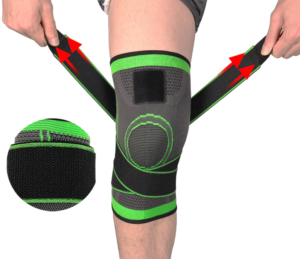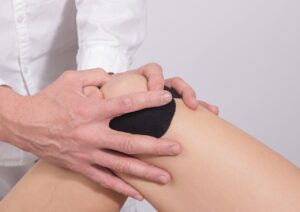
In this article, we’ll explore the fascinating world of knee compression sleeves. These versatile garments have gained popularity for their ability to provide support and stability to the knee joint. Whether you’re an athlete recovering from an injury or someone who experiences occasional knee discomfort, understanding the benefits and drawbacks of knee compression sleeves can help you make an informed decision about whether they’re right for you. So, let’s dive into the world of knee compression sleeves and discover how they can potentially enhance your knee health!

This image is property of pixabay.com
Benefits of Knee Compression Sleeves
Reduced pain and inflammation
Knee compression sleeves are known for their ability to provide relief from pain and inflammation. The compression applied to the knee helps to reduce swelling and alleviate discomfort. By applying gentle pressure to the affected area, the sleeves can help to minimize the sensation of pain and promote healing.
Improved stability and support
One of the significant benefits of knee compression sleeves is the improved stability and support they offer. The tight fit and compression provided by these sleeves help to stabilize the knee joint and prevent unnecessary movements. This can be particularly beneficial for individuals who have previously experienced knee injuries or have weak or unstable knees.
Increased blood flow and oxygen delivery
Another advantage of knee compression sleeves is their ability to increase blood flow and oxygen delivery to the muscles surrounding the knee. The compression stimulates blood circulation, which can aid in the recovery and healing process. Improved blood flow also helps to deliver essential nutrients and oxygen to the knee, promoting overall joint health.
Reduced muscle fatigue
Knee compression sleeves can help reduce muscle fatigue during physical activities by providing support to the muscles surrounding the knee. The compression applied by the sleeves helps to stabilize the muscles, leading to reduced muscle vibration and energy expenditure. When muscles are adequately supported, they are less likely to become fatigued, allowing you to perform at your best for longer periods.
Protection and injury prevention
By providing additional support and stability, knee compression sleeves can help to protect the knee joint from potential injuries. They act as a barrier against external forces and impacts that could otherwise damage the knee. Additionally, the compression sleeves can aid in preventing re-injury by reducing unnecessary movements and providing reinforcement to weakened or strained muscles.
Drawbacks of Knee Compression Sleeves
Potential discomfort and irritation
While knee compression sleeves can provide various benefits, some individuals may experience discomfort or irritation when wearing them. The snug fit and pressure applied to the knee can sometimes cause discomfort, especially if the sleeves are too tight or if they are worn for extended periods. It is essential to find the right size and fit to avoid any unnecessary discomfort.
Limited range of motion
A potential drawback of knee compression sleeves is the restricted range of motion they can impose on the knee joint. The compression provided by the sleeves can limit the joint’s ability to move freely, potentially hindering certain activities or sports. It is important to strike a balance between the support provided by the sleeves and the need for flexibility and mobility in specific movements.
Dependency and reliance
One potential drawback to consider when using knee compression sleeves is the risk of dependency and reliance. Some individuals may become dependent on the support provided by the sleeves and rely on them excessively, instead of addressing the underlying issue causing knee problems. It is essential to use knee compression sleeves as part of a comprehensive treatment plan and not solely as a long-term solution.
Incorrect use can cause harm
Improper use of knee compression sleeves can potentially cause harm rather than providing the intended benefits. Wearing the wrong size, wearing them for extended periods, or using them inappropriately during activities may lead to discomfort, restricted blood flow, or exacerbation of existing knee issues. It is crucial to follow the manufacturer’s instructions and consult with a healthcare professional to ensure proper and safe usage.

This image is property of pixabay.com
Factors to Consider when using Knee Compression Sleeves
Choosing the right size and fit
When selecting knee compression sleeves, choosing the right size and fit is crucial. This ensures that you receive the maximum support and benefits while minimizing discomfort. Take accurate measurements of your knee circumference and refer to the sizing chart provided by the manufacturer to find the appropriate size.
Consulting with a healthcare professional
Before using knee compression sleeves, it is advisable to consult with a healthcare professional, such as a physiotherapist or orthopedic specialist. They can evaluate your specific condition or injury and provide guidance on whether knee compression sleeves are suitable for you. Their expertise can help determine the most effective approach for your situation.
Understanding the underlying condition
It is important to have a clear understanding of your underlying condition or injury before using knee compression sleeves. Each individual’s situation is unique, and different knee problems may require varying levels of support or specific types of sleeves. Understanding the extent of your condition can help you make an informed decision regarding the type and level of support needed.
Using in conjunction with other treatments or therapies
Knee compression sleeves are not meant to be a standalone treatment but rather a complementary tool for managing knee issues. It is essential to use them in conjunction with other recommended treatments or therapies, such as physical therapy, exercises, or medication. This comprehensive approach can provide holistic care and optimize your recovery.
Discontinuing use if adverse effects occur
If you experience any adverse effects or increased pain when wearing knee compression sleeves, it is crucial to discontinue their use and seek further medical advice. While knee compression sleeves can be beneficial for many individuals, everyone’s circumstances are different, and monitoring your symptoms is essential to ensure your overall well-being.
Difference between Compression Sleeves and Braces
Purpose and functionality
Compression sleeves and braces serve different purposes and provide different functionalities for knee support. Compression sleeves primarily focus on providing compression, stability, and promoting blood flow, helping with pain relief and mild knee issues. Braces, on the other hand, are designed to restrict movement and provide more significant support, often used for moderate to severe knee injuries or during post-surgery recovery.
Degree of support and stabilization
Compression sleeves offer moderate support and stabilization to the knee joint. While they provide compression, they do not restrict movement significantly. Braces, in contrast, are designed to limit movement and provide more substantial support to the knee ligaments and tendons, allowing for proper healing and minimizing the risk of further injury.
Flexibility and mobility
Compression sleeves are known for their flexibility and mobility, allowing for a wider range of motion in the knee joint. The compression they provide is evenly distributed, allowing for comfortable movement during various activities. Braces, due to their more rigid nature, can inhibit certain movements, particularly those that involve bending or twisting, in order to protect the injured knee.
Conditions and injuries they are suitable for
Compression sleeves are commonly used for mild knee conditions, such as arthritis, tendonitis, or general knee pain. They are also beneficial for reducing muscle fatigue during physical activities. Braces, on the other hand, are typically recommended for more severe knee injuries, such as ligament tears, sprains, or following surgical procedures. They provide the necessary support and stabilization required for proper healing.

This image is property of pixabay.com
Research and Evidence on the Effectiveness of Knee Compression Sleeves
Clinical studies and findings
Numerous clinical studies have been conducted to examine the effectiveness of knee compression sleeves in managing various knee-related conditions. While individual study results may vary, research has generally shown positive outcomes in terms of pain reduction, improved stability, and enhanced muscle performance. These studies provide scientific evidence supporting the benefits of knee compression sleeves.
Expert opinions and recommendations
Experts in the fields of sports medicine, orthopedics, and rehabilitation often recommend knee compression sleeves as part of treatment plans for knee-related issues. Their expertise and experience contribute to the overall consensus that knee compression sleeves can provide valuable benefits, particularly for individuals with mild to moderate knee conditions or for athletes looking to prevent injuries.
User testimonials and experiences
User testimonials and personal experiences also provide valuable insight into the effectiveness of knee compression sleeves. Many individuals have shared their positive experiences with these sleeves, citing reduced pain, increased mobility, and enhanced athletic performance. While personal anecdotes should not be considered as entirely scientific evidence, they do contribute to the overall understanding of the potential benefits of knee compression sleeves.
Common Misconceptions about Knee Compression Sleeves
They can cure knee problems
One common misconception about knee compression sleeves is that they can cure knee problems. While they can provide relief and support, knee compression sleeves do not treat the underlying causes of knee issues. They should be seen as a supportive tool to manage symptoms and aid in the recovery process, but they cannot cure knee problems on their own.
They can replace medical treatments
Another misconception is that knee compression sleeves can replace medical treatments or interventions. While they can be an important part of a treatment plan, knee compression sleeves should not be seen as a substitute for professional medical advice or prescribed treatments. It is essential to follow the guidance of healthcare professionals and use knee compression sleeves as a supplementary aid alongside other recommended therapies.
They are only for athletes or active individuals
Some people believe that knee compression sleeves are exclusively for athletes or active individuals. While athletes often use these sleeves to enhance their performance and prevent injuries, knee compression sleeves can benefit anyone experiencing knee problems or looking for additional support during physical activities. They are not limited to a specific group and can be used by individuals of all lifestyles and activity levels.
Tips for Choosing and Using Knee Compression Sleeves
Measure your knee accurately
Accurate measurements of your knee circumference are essential when choosing knee compression sleeves. Use a measuring tape to measure the widest part of your knee, typically right above the kneecap, to ensure you select the appropriate size.
Select the appropriate level of compression
Knee compression sleeves come in different levels of compression. Consider the severity of your knee condition or injury when choosing the compression level. Mild compression is suitable for general support and prevention, while higher compression levels are typically recommended for more specific therapeutic purposes or after injury.
Ensure proper placement and alignment
Proper placement and alignment of knee compression sleeves are crucial to maximize their benefits. Align the sleeve with the center of your kneecap and smooth out any wrinkles or folds to ensure a snug fit. The compression should be evenly distributed around the knee joint.
Follow manufacturer instructions for care and maintenance
Each manufacturer may have specific care instructions for their knee compression sleeves. It is important to read and follow these instructions to maintain the integrity and effectiveness of the sleeves. Proper care and maintenance can also extend the lifespan of the sleeves and ensure their continued benefits.
Monitor your symptoms and adjust accordingly
Regularly monitor your knee symptoms and evaluate the effectiveness of the knee compression sleeves. If you notice any changes or increased discomfort, it may be necessary to adjust the fit, compression level, or consult with a healthcare professional for further guidance.
Types of Knee Compression Sleeves
Open patella vs. closed patella sleeves
Open patella knee compression sleeves have a circular opening at the front, exposing the patella or kneecap. This design helps to relieve pressure on the patella and reduce any discomfort caused by direct compression. Closed patella sleeves, on the other hand, provide full coverage and compression over the entire knee joint, including the patella.
Neoprene vs. fabric sleeves
Knee compression sleeves are available in different materials, with neoprene and fabric being the most common. Neoprene sleeves offer excellent durability, insulation, and compression. Fabric sleeves, typically made from breathable materials, provide a more lightweight and flexible option, which can be beneficial for individuals looking for increased comfort or who engage in activities with prolonged use.
Full-length vs. knee-length sleeves
Full-length knee compression sleeves extend from the upper thigh down to the calf, providing comprehensive coverage and compression to the entire knee joint and surrounding muscles. Knee-length sleeves, also known as sleeve-style braces, cover the knee and immediate surrounding area. The choice between full-length and knee-length sleeves depends on individual preferences, the extent of the knee condition, and desired support level.
Custom-made vs. off-the-shelf sleeves
Custom-made knee compression sleeves are specifically tailored to fit an individual’s unique knee measurements and contours. These sleeves offer a precise fit and targeted support but can be more expensive and require professional measurement and fitting. Off-the-shelf knee compression sleeves are readily available in standard sizes and can be purchased without customization, making them more accessible and cost-effective for many individuals.
Popular Brands and Models of Knee Compression Sleeves
Brand A and its features
Brand A offers knee compression sleeves that are known for their high-quality materials, excellent compression, and durability. They provide a wide range of sizes to ensure a proper fit for various body types. These sleeves are designed with moisture-wicking and breathable fabrics, making them comfortable to wear during various activities. Their open-patella design offers targeted compression while still allowing for optimal mobility.
Brand B and its features
Brand B focuses on providing knee compression sleeves that offer a balance between support, comfort, and flexibility. Their fabric sleeves are made with a combination of materials that provide both compression and breathability, ensuring optimal performance. These sleeves come in different compression levels and lengths to suit individual needs and preferences. Their closed-patella design provides comprehensive coverage and support to the entire knee joint.
Brand C and its features
Brand C specializes in custom-made knee compression sleeves, offering a personalized fit and level of support. Their sleeves are made from high-quality materials and provide targeted compression to specific areas of the knee. With a focus on precision and customization, Brand C aims to provide optimal support and relief for individuals with unique knee conditions or injuries. Their custom-made sleeves are often recommended by healthcare professionals for their superior fit and effectiveness.
Conclusion
In conclusion, knee compression sleeves offer various benefits for individuals experiencing knee problems or looking to prevent injuries during physical activities. They can reduce pain and inflammation, improve stability and support, increase blood flow and oxygen delivery, and protect against potential injuries. However, it is important to consider potential drawbacks such as potential discomfort, limited range of motion, dependency, and incorrect usage. Factors to consider when using knee compression sleeves include choosing the right size and fit, consulting with a healthcare professional, understanding the underlying condition, using in conjunction with other treatments or therapies, and discontinuing use if adverse effects occur. Differentiating knee compression sleeves from braces is essential, as they serve different purposes and provide varying degrees of support and stabilization. Research, expert opinions, and user testimonials support the effectiveness of knee compression sleeves. It is important to dispel common misconceptions and follow tips for choosing and using knee compression sleeves, such as measuring accurately, selecting appropriate compression level, ensuring proper placement, following manufacturer instructions, and monitoring symptoms. There are various types of knee compression sleeves available, including open patella vs. closed patella sleeves, neoprene vs. fabric sleeves, full-length vs. knee-length sleeves, and custom-made vs. off-the-shelf sleeves. Popular brands and models of knee compression sleeves offer different features and options to suit individual needs. Overall, knee compression sleeves can provide valuable benefits when used appropriately and in conjunction with a comprehensive treatment plan. By understanding the benefits, drawbacks, and considerations associated with knee compression sleeves, individuals can make informed decisions to optimize their knee health and wellbeing.





